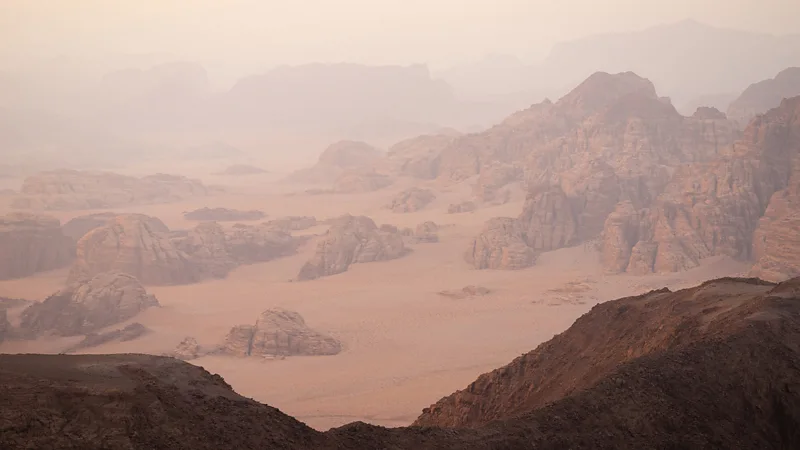Jordan’s Wadi Rum Desert, with its brilliant red sands, towering rock formations and ancient Bedouin culture, offers one of the world’s most breathtaking landscapes. Now, it’s also home to a new long-distance hiking route – the Wadi Rum Trail. Unveiled in early 2023, this 120-kilometer loop offers an experience that combines the natural beauty of Wadi Rum with the cultural richness of the Bedouin people who have called this place home for generations. The Wadi Rum Trail is more than just a hike; it’s a journey through time, tradition and some of the most dramatic desert scenery on the planet.
Introducing the Wadi Rum Trail
The Wadi Rum Trail is a 10-day hiking route that takes adventurers deep into Jordan’s Wadi Rum Protected Area, a UNESCO World Heritage Site. Unlike more popular 4×4 tours that follow well-trodden paths, this trail heads into lesser-known areas, crossing valleys, gorges, cliffs and mountains that most visitors never see. Created in collaboration with local Bedouin guides and international adventurers, the trail offers a unique opportunity to explore the vast and varied desert landscapes that have inspired countless travelers, including people like T.E. Lawrence, whose early-20th-century adventures immortalized Wadi Rum in his book “Seven Pillars of Wisdom.”

A landscape that feels otherworldly
Wadi Rum is often described as a place that feels like another planet. In fact, its rugged terrain has been used as a stand-in for Mars in films like The Martian (2015) and Star Wars: The Rise of Skywalker (2019). The desert is characterized by its sharp, red sand and tall sandstone mountains, some of which rise to nearly 2,000 meters. The mountains also contain deep gorges and narrow valleys that create a maze-like landscape. The Wadi Rum Trail passes through these dramatic formations, giving hikers a chance to see the breathtaking beauty of the region up close.
In the first stage of the trail, hikers are taken to the cliffs of Jebel Umm Ishrin, a massive sandstone mountain that stands 1,753 meters high. Here, the route passes through narrow gorges and steep peaks, from where spectacular views of the surrounding desert are offered. It is not uncommon to hear the whistling sounds of starlings echoing off the rocks – a sound that Bedouins believe mimics the voices of ancient spirits. Along the journey, hikers encounter ancient petroglyphs, Thamudic inscriptions, and even Nabataean temples carved into rock, reminders of the people who have lived and traveled in the region for millennia.
Bedouins: Guardians of Wadi Rum
The Wadi Rum Trail isn’t just about exploring the physical landscape; it’s also about connecting with the Bedouin people who have lived in this desert for centuries. The trail’s creators, including British adventurer Ben Hoffler and mountaineer Tony Howard, worked closely with the local Zalabieh tribe to ensure the route benefits the community. The Bedouin people of Wadi Rum have a deep understanding of the land, and their knowledge of the terrain, flora, and fauna has been passed down for generations.

Hiking the trail without a Bedouin guide is permitted, but doing so means missing out on a treasure trove of local knowledge. Bedouin guides not only help hikers through the often challenging terrain, but also share stories of their culture and traditions, providing an experience that is far more rich and meaningful than just a scenic walk.
“The Wadi Rum Trail first and foremost pays tribute to the Bedouins of Wadi Rum,” Howard said. “They know the area, its flora and fauna intimately from ancestral knowledge – and they are always good company and fun!” The trail is seen as a way to keep Bedouin culture alive, provide younger generations with meaningful work that connects them to their heritage and promote a more sustainable form of tourism.
A sustainable alternative to mass tourism
Unlike the typical 4×4 tours that dominate Wadi Rum’s tourism industry, the Wadi Rum Trail offers a more sustainable way to explore the desert. By taking it slow and traveling on foot, hikers are able to fully enjoy the natural beauty and tranquility of the area. The trail deliberately avoids popular tourist sites and instead takes hikers to remote areas where they are unlikely to encounter other visitors. This approach not only reduces the environmental impact of tourism but also helps spread the benefits more evenly across the local community.

As cultural anthropologist Tatiana Haddad said, “The creation of the trail symbolizes a growing consideration of Wadi Rum’s ecological fragility and the vitality of its preservation.” Desert ecosystems, despite their harsh appearance, are surprisingly delicate, and the Wadi Rum Trail aims to promote a deeper understanding of this unique environment. The trail is carefully managed to ensure that.
